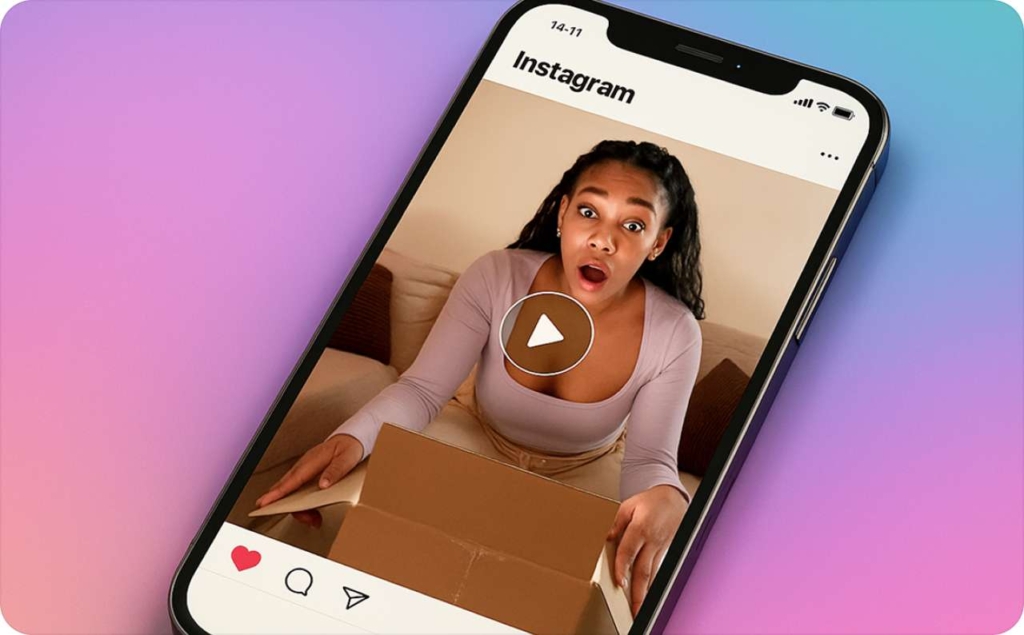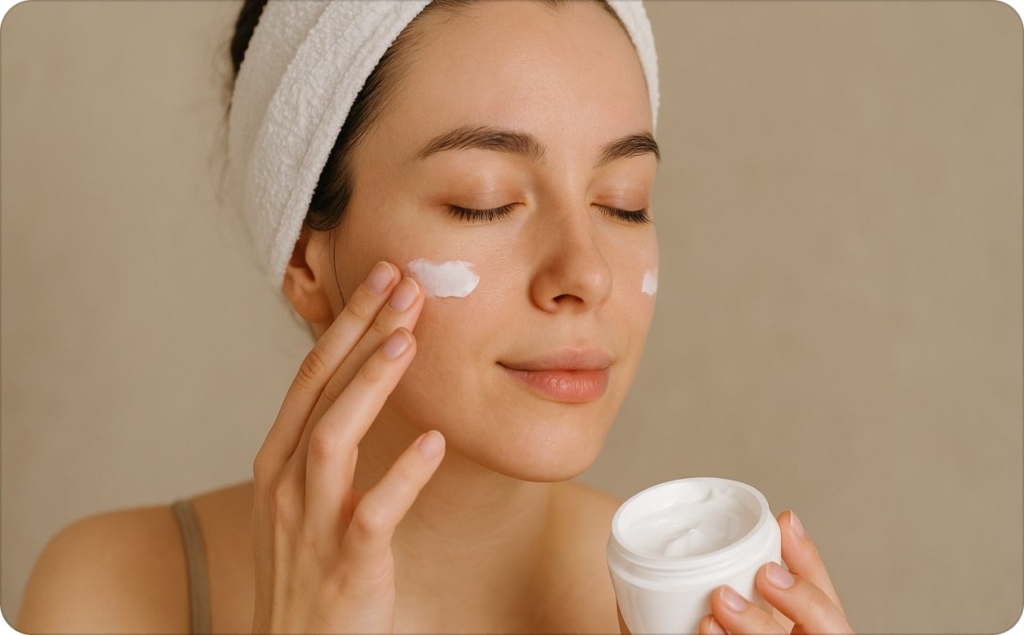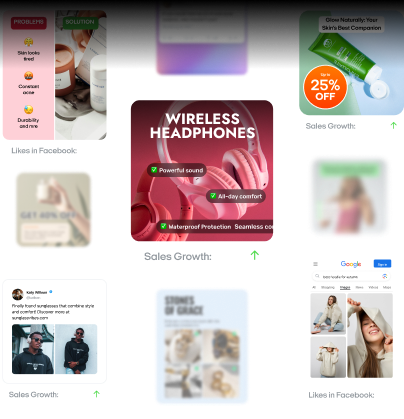Top 13 AI-powered marketing campaigns of 2025
How are brands using AI to win in 2025? Zeely AI highlights 13 of the most impactful AI-driven marketing campaigns that redefine creativity, personalization, and ROI.
AI marketing campaigns in 2025 deliver viral reach, personalization at scale, and measurable ROI without large budgets. This guide presents the best AI marketing campaigns examples of 2025 and shows how small brands can apply the same tactics.
An effective AI marketing campaign uses cultural insight, generative creativity, and data-driven personalization to convert attention into sales. Coca-Cola co-created visuals with fans using generative AI. Nike tailored creative for niche subcultures. Heinz used AI imagery to strengthen brand identity. Sephora applied predictive tools for targeted offers. Zeely enabled small teams to produce on-brand ads in minutes.
The campaigns here were selected for impact, replicability, and budget efficiency. Topics include generative AI ads, personalization at scale, conversational AI, visual branding, and case studies with clear action steps.

13 real AI-powered campaigns you can learn from
These AI campaign case studies reveal how brands — from fast food to luxury retail, use artificial intelligence to unlock speed, personalization, innovation, and cultural relevance. Each block includes what was done, why it mattered, measurable outcomes, and how you can replicate it.
Small brands punching above their weight
AI is leveling the playing field for small businesses, letting one-person operations and local shops create campaigns that look and perform like big-budget productions. These examples show how accessible tools like Zeely AI can turn limited resources into measurable growth.
Sierra Gold Horses: From decline to sales surge with Zeely AI
Dan Houdeshell runs Sierra Gold Horses in Twin Falls, Idaho, selling supplements for horses, dogs, and cattle. Facing falling web traffic, low video engagement, and no marketing budget, he turned to Zeely AI for a solution. Using AI-generated scripts, timing, and music-driven visuals, he produced short-form ads that immediately captured attention, like a barrel race clip perfectly synced to music.
Strategic impact: Shifted from DIY, low-impact videos to professional-quality campaigns without extra staff or costs.
Key insight: Music-driven, motion-first creative can outperform traditional product-talk formats in rural niche markets.
Performance outcomes
- Website traffic grew from under 3% to over 7%
- Watch time exceeded the initial 2–3 seconds
- 40% sales increase for MellowMAX formulas in one week
- Revived a low-volume SKU
- Direct sales from organic social ads
Takeaway: With AI, even niche rural brands can create high-impact, sales-driving ads in minutes.
Hard Wood BBQ: Rekindling business after a pandemic pause
Rick, owner of Hard Wood BBQ, had been out of the food and beverage game since COVID. With no ad experience and zero editing skills, marketing felt intimidating, until he tried Zeely AI. Starting with pre-built templates, he created short, heartfelt ads that matched his brand’s rustic feel. A Father’s Day spot became his turning point, generating strong engagement and real orders.
Strategic impact: Transformed from marketing novice to multi-platform advertiser without outside help.
Key insight: Personal, story-driven ads resonate, especially when supported by authentic customer content.
Performance outcomes
- 18 short-form videos produced in weeks
- 3 top-performing ad formats identified and refined
- 41 hits in 24 hours after the first video
- Consistent orders and positive viewer feedback
Takeaway: AI removes the technical barrier to creative production, making it possible for small food and beverage brands to market like seasoned pros.
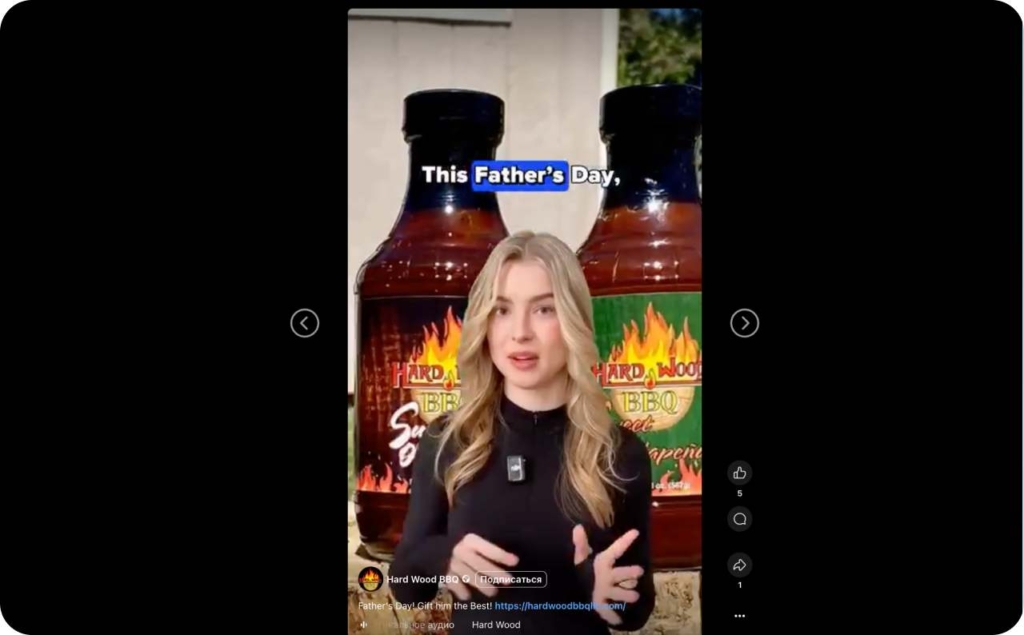
Photo source: Hard Wood BBQ
AI that goes viral
Viral campaigns in 2025 aren’t just born from luck — they’re engineered with precision. AI now gives brands the ability to read cultural signals in real time, create reactive content within hours, and amplify it before the moment fades.
The following examples show how leading companies turned everyday conversations, major events, and even playful audience challenges into global buzz, proving that speed, cultural relevance, and creativity are the new currency of virality.
Popeyes: “Wrap Battle” social showdown
Popeyes launched the “Wrap Battle” campaign using AI to produce music video-style ads for its chicken wraps. The system generated customized diss tracks, matching lyrics and visuals to trending social conversations in different U.S. cities. AI-powered sentiment analysis identified the best-performing creative within 48 hours, allowing Popeyes to scale winning variants across TikTok, Instagram, and YouTube. This approach turned local banter into nationwide buzz.
Strategic impact: Transformed a product launch into an interactive cultural event, using AI to react and adapt faster than traditional creative cycles.
Key insight: AI-driven content iteration lets brands own the conversation while it’s still fresh.
Performance outcomes
- 45% increase in social engagement compared to previous campaigns
- 23% lift in wrap sales during the first two weeks
- Content scaled to national reach in under 72 hours
Takeaway: Use AI to spot, produce, and amplify culturally relevant creative before the moment passes.
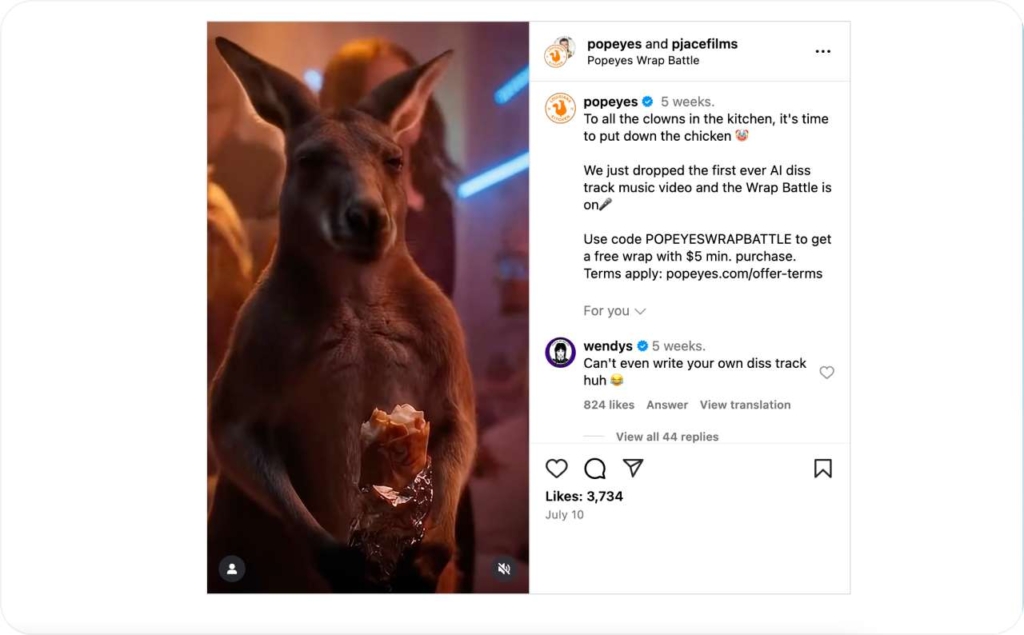
Photo source: @popeyes on Instagram
Kalshi & Coign: NBA finals fully ai-generated ads
Financial platform Kalshi partnered with payment brand Coign to launch a fully AI-generated ad series during the NBA Finals. The campaign used generative AI to create hyper-realistic basketball scenes, player avatars, and dynamic crowd reactions without a single live shoot. Copy, voiceovers, and motion graphics were produced in real time, adapting to game outcomes and trending fan discussions on social media. This allowed the ads to stay contextually relevant through each game in the series.
Strategic impact: Delivered a major-event campaign at a fraction of the usual cost while matching the speed of real-world sports drama.
Key insight: Generative AI can turn high-stakes, fast-paced events into real-time branded storytelling.
Performance outcomes
- 52% reduction in production costs compared to traditional sports ads
- 37% higher ad recall among NBA fans in post-game surveys
- Creative turnaround time dropped from weeks to under 24 hours per spot
Takeaway: Leverage generative AI to produce event-based creative that reacts as fast as the action unfolds.
Lidl “Lidlize” campaign: Democratizing creativity
French grocery giant Lidl turned everyday shoppers into brand designers with its “Lidlize” campaign. A custom generative AI platform let users transform any object — from a toaster to a bouncy castle, into Lidl’s signature red, blue, and yellow palette. Every design was instantly rendered in photorealistic quality, inviting mass participation. The twist: the most-liked creation would be produced as a real product and sold in stores.
Strategic impact: Shifted Lidl from a traditional retailer to a co-creation powerhouse, fueling brand engagement without traditional ad spend.
Key insight: Empowering audiences with AI-driven creativity turns customers into viral content creators and brand advocates.
Performance outcomes
- 1.7M+ unique visuals generated in three weeks
- Peak activity: 1,000 image requests per minute
- Multiple awards, including D&AD Wood Pencils and Cannes Lions
- Significant organic reach with zero paid media costs
Takeaway: Use AI co-creation to democratize brand storytelling, scale user-generated content, and deepen loyalty without inflating budgets.
AI personalization at scale
Personalization at scale is no longer a luxury, it’s the standard for high-performing campaigns in 2025. AI enables brands to adapt offers, creatives, and recommendations in real time, matching each customer’s unique preferences and behaviors. The following examples show how leading companies combine predictive analytics, dynamic content, and adaptive targeting to make every interaction feel tailored, whether you’re browsing luxury jewelry, a handmade marketplace, or a social media feed.
Sephora: AI-powered personalized beauty
Beauty retailer Sephora implemented AI-driven personalization tools to enhance customer experience both online and in-store. Utilizing deep learning and extensive data from over 70,000 skin images, Sephora’s AI-powered Virtual Artist and Smart Skin Scan provided tailored product recommendations and beauty routines. The system adapted in real time to user preferences, skin tone, and purchase history, delivering highly customized suggestions and tutorials.
Strategic impact: Combined Sephora’s expert beauty knowledge with AI’s precision to create hyper-personalized, data-driven experiences across channels.
Key insight: AI enhances customer engagement and satisfaction by offering individualized beauty solutions that evolve with user behavior.
Performance outcomes
- +34% increase in customer retention
- 29% boost in conversion rates on personalized product pages
- 18% reduction in product returns due to better fit and match
Takeaway: AI-powered beauty personalization transforms the retail experience, making it uniquely tailored and more effective at scale.
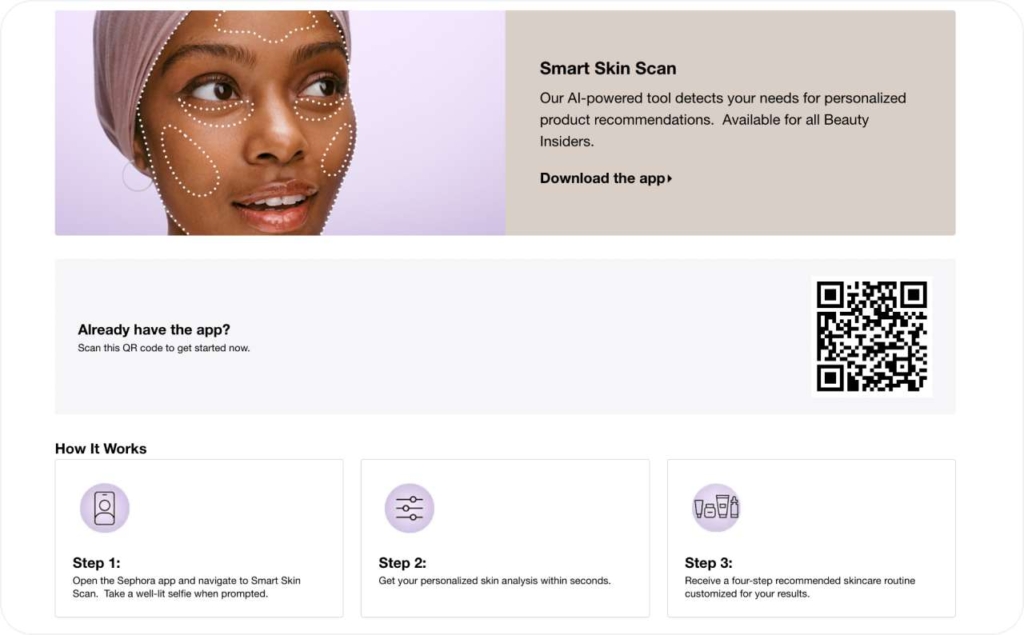
Photo source: Sephora
Etsy: Dynamic personalization engine
Etsy deployed an AI-driven personalization engine that tailors search results and homepage layouts for each shopper. By analyzing past purchases, browsing patterns, and engagement with handcrafted items, Etsy’s AI predicts high-likelihood purchases and rearranges product displays in real time. Seasonal events, like Valentine’s Day, trigger instant shifts in recommendations.
Strategic impact: Turned Etsy’s vast marketplace into a curated boutique experience for every user.
Key insight: Dynamic personalization makes large inventories feel intimate and navigable.
Performance outcomes
- 23% increase in conversion rates
- 15% improvement in repeat purchase frequency
- Higher engagement time per session — +19%
Takeaway: Real-time adaptation ensures relevance even in high-volume marketplaces.

Meta: Predictive creative optimization
Meta rolled out AI-powered predictive creative optimization for advertisers, automatically testing and serving ad variants based on individual user behavior. The system learns which visuals, copy, and calls-to-action resonate with micro-segments, updating campaigns in-flight without manual intervention.
Strategic impact: Enabled advertisers to scale personalization across millions of impressions without additional creative overhead.
Key insight: Continuous AI-driven testing keeps campaigns optimized for changing audience preferences.
Performance outcomes
- 32% reduction in cost per acquisition
- 40% faster identification of high-performing creatives
- Significant lift in ad relevance scores across verticals
Takeaway: AI personalization works best when it adapts both targeting and creative elements in real time.
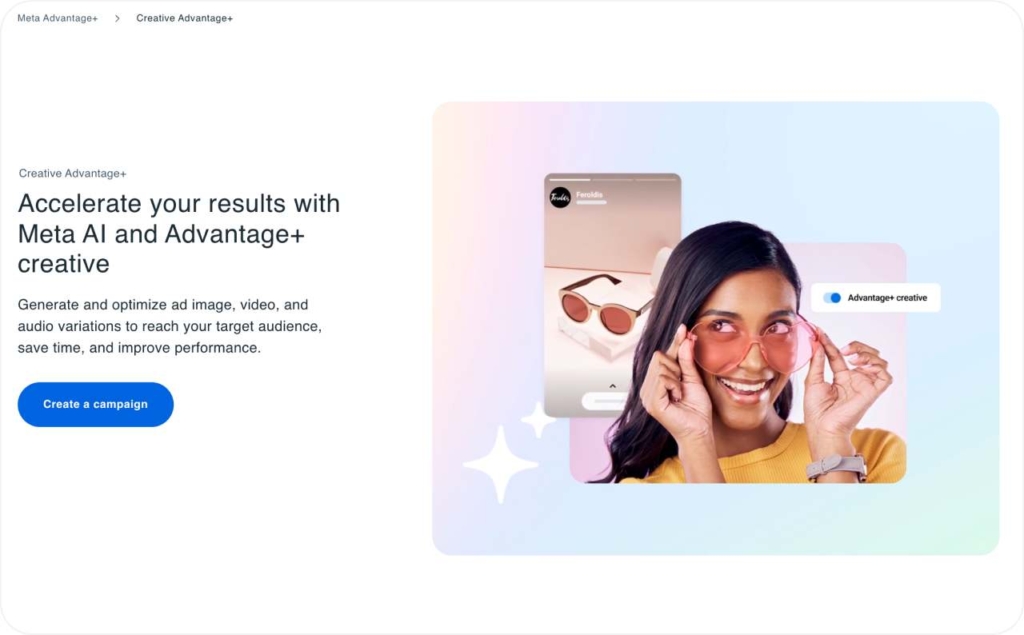
Conversational and voice AI
Conversational and voice AI is transforming how brands connect with customers, removing friction, simplifying complex tasks, and delivering instant, personalized responses. Whether it’s media planning, smartphone interactions, or booking travel, these tools turn everyday exchanges into high-conversion brand touchpoints. The following examples show how leading companies are making AI interactions natural, useful, and commercially impactful.
Spectrum Reach: Architect AI media planning assistant
Spectrum Reach launched Architect, an AI-powered conversational assistant that helps businesses plan media campaigns through a natural chat interface. Users can describe their goals, such as “I want to reach parents in Austin with back-to-school ads”, and Architect instantly generates a cross-platform media plan with budget allocations, audience targeting, and optimal ad formats. The assistant learns from campaign performance, refining future recommendations automatically.
Strategic impact: Made professional-grade media planning accessible to small and mid-sized businesses without agency fees.
Key insight: Conversational AI can remove complexity from technical processes, lowering the barrier to advanced marketing tools.
Performance outcomes
- Reduced media planning time from weeks to under 10 minutes
- 27% improvement in campaign ROI for SMB users
- Increased customer retention for Spectrum Reach by 18%
Takeaway: Use conversational AI to democratize expertise-heavy processes and empower non-specialists to make data-driven decisions.
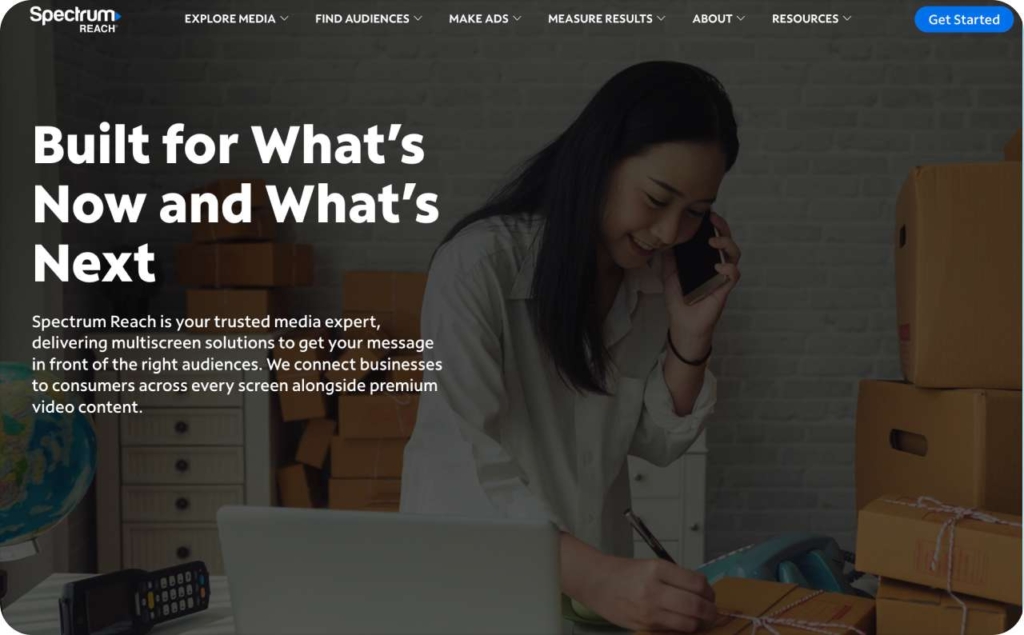
Google: Pixel 10 “Ask More of Your Phone”
To launch the Pixel 10, Google showcased its upgraded voice AI capabilities with the “Ask More of Your Phone” campaign. Ads demonstrated how users could ask complex, context-aware questions, like “Find me photos from last summer with my dog at the lake”, and get instant, accurate results. The voice assistant integrated with Google Lens, Calendar, and Maps, turning multi-step tasks into a single spoken request.
Strategic impact: Positioned Pixel 10 as a productivity hub, not just a smartphone, by emphasizing problem-solving through conversation.
Key insight: Voice AI adoption grows when it’s marketed as a practical, time-saving tool rather than a novelty.
Performance outcomes
- 19% increase in purchase intent within target audiences
- 25% higher engagement with interactive in-store demos
- Boosted Google Assistant daily usage by 17% among Pixel owners
Takeaway: Show real-life scenarios where voice AI removes friction, and adoption will follow.
Super.com: Chat-based hotel booking reinvented
Toronto-based Super.com, previously SnapTravel redefined travel booking with an AI-powered chatbot available on SMS, WhatsApp, and Facebook Messenger. Travelers can type natural requests, like “Find me a 4-star hotel in Paris under $200”, and the AI instantly searches hundreds of sources for the best deals, often delivering savings of up to 50%. Beyond pricing, the system personalizes recommendations based on location, amenities, and budget, creating a concierge-like experience without an app download.
Strategic impact: Shifted hotel booking from static search forms to real-time conversational commerce, streamlining decision-making for mobile-first users.
Key insight: When AI blends price discovery with personalized recommendations inside a familiar messaging platform, conversion rates soar.
Performance outcomes
- Facilitated 350,000+ hotel nights across 150+ countries
- Generated over $350M in sales since launch
- Reached profitability in 60 days during the pandemic despite an 80% drop in bookings
- Expanded into Snapcommerce, backed by Stephen Curry and Expedia’s CEO
Takeaway: Conversational AI can transform transactional services into personalized, high-conversion experiences, especially in mobile-first markets.

AI in visual branding
AI is redefining how brands approach visual identity, streamlining production, enhancing inclusivity, and creating dynamic, immersive experiences. These campaigns show how machine-generated design can scale creative output while staying true to brand values.
Zalando: AI-generated fashion models
Zalando integrated AI-generated models into its product photography workflow, creating photorealistic images that reflect diverse skin tones, body types, and styles for its global audience. The system could produce localized visuals in hours, replacing the need for multiple regional photoshoots. This approach cut production time by 60% and boosted engagement in localized markets by 14%.
Strategic impact: Expanded representation while reducing seasonal catalog update costs and timelines.
Key insight: AI-generated imagery enables brands to instantly reflect audience diversity and maintain authenticity.
Performance outcomes
- 60% faster content production
- +14% engagement in targeted regions
Takeaway: Use AI visuals to create inclusive branding at speed and scale.
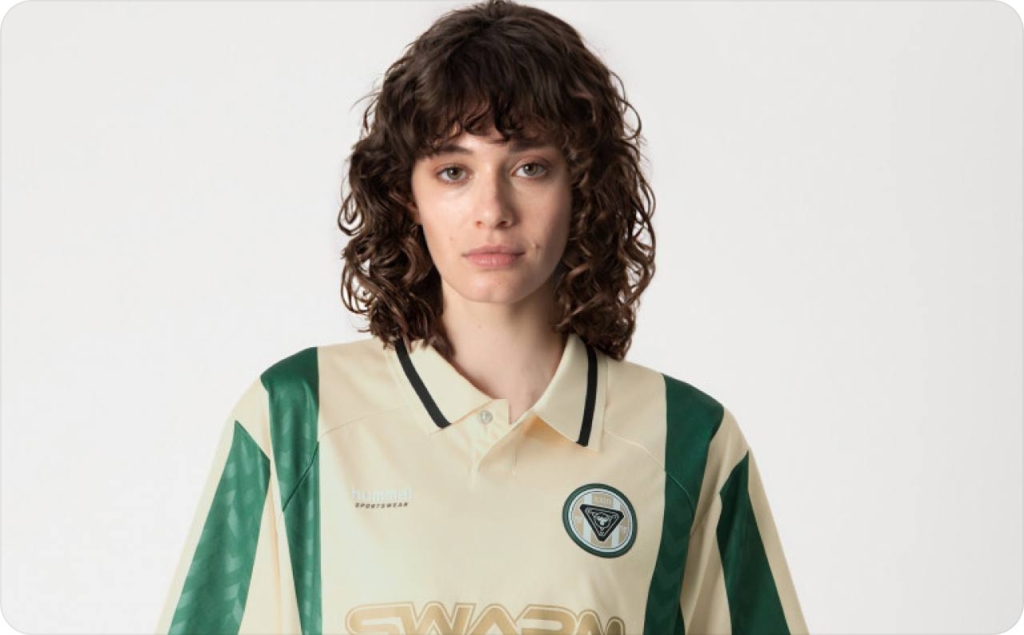
Nike: Customizable AI avatars for Nikeland
Nike brought personalization into its Roblox-based Nikeland platform with AI-generated avatars. Users could upload a selfie or select from preset options, and AI would adapt facial features, outfits, and accessories to match Nike’s latest drops. This allowed fans to see themselves wearing new products in real time, increasing in-platform engagement and product page visits.
Strategic impact: Bridged virtual and real-world retail experiences, turning digital play into a direct product consideration channel.
Key insight: When AI customization feels personal and playful, it drives both digital engagement and real-world sales interest.
Performance outcomes
- 2.3M+ unique avatar creations within the first month
- 19% lift in click-through rates to product pages from Nikeland
Takeaway: Blend AI-driven personalization with immersive environments to make brand experiences more interactive and commerce-ready.

How to create successful AI campaigns
Creating a successful AI-powered campaign means covering every step of the process — from building ads to optimizing performance. With modern AI tools like Zeely AI, you can start by generating impressive static ads and engaging videos using an AI ad builder, ensuring that your creatives are tailored to grab attention right from the start.
Once the visuals are ready, you can seamlessly launch your campaign with an automated ad creator, setting your own budget and aligning it with your business goals. Zeely AI enhances your results by enabling A/B testing even if you don’t have professional skills in how to automate ad campaigns with AI, so you can experiment with different versions of your ads and discover what resonates best with your audience.
Finally, built-in optimization algorithms ensure that your campaigns are automatically refined, directing budget toward the highest-performing ads and helping you achieve the best possible outcomes with minimal effort.

Why AI marketing campaigns are dominating 2025
AI marketing campaigns lead in 2025 because they combine speed, creative scale, and real-time personalization — advantages traditional marketing can’t match. These capabilities let you launch relevant, data-backed ads faster and at lower cost.
Speed that captures trends
Generative AI tools create ad visuals, copy, and videos in hours, not weeks. This lets you respond to market shifts or cultural moments before they fade. For example, a small fashion brand can design and publish an AI-generated lookbook in a single day, keeping pace with major retailers.
Creative scale without large teams
Machine learning models adapt one concept into hundreds of variations for different audiences, regions, or platforms. Zeely, for instance, lets small teams produce multiple ad formats from one idea, covering Instagram, TikTok, and YouTube without hiring extra designers.
Personalization in real time
Predictive analytics and AI-powered targeting update campaigns as user behavior changes. Offers, visuals, and calls to action shift dynamically to match audience interests, boosting click-through rates and lowering cost per acquisition. Sephora’s AI-driven recommendations are a proven example of this in action.
Cultural alignment at scale
AI analyzes social trends, search queries, and content engagement to surface what’s culturally relevant now. Chatbots and conversational AI integrate these insights into campaigns, making interactions feel timely and authentic. Coca-Cola’s generative campaigns tied to trending art styles illustrate this advantage.
Why this matters for you
Traditional marketing cycles are slow and resource-heavy. AI enables agile marketing — faster testing, broader creative output, and measurable performance gains. For small brands, that means competing directly with industry leaders on reach and relevance. Want to test an AI ad generator built for small teams? Try Zeely AI today.
Conclusion: Turning AI marketing insights into action
The campaigns in this guide show that AI is now a core driver of marketing success, not an experiment. Brands of all sizes are using it to produce faster, more relevant, and more personalized campaigns, often at a fraction of traditional costs. Popeyes reacted to cultural moments in hours, Swarovski delivered real-time luxury recommendations, and small businesses like Sierra Gold Horses and Hard Wood BBQ achieved measurable sales growth without hiring agencies.
The lesson is simple: speed, personalization, and cultural relevance win in 2025. With the right AI tools, you can compete with industry leaders, launch creative in hours, and adapt campaigns in real time. The next breakthrough campaign could be yours, start building it today.
Also recommended
